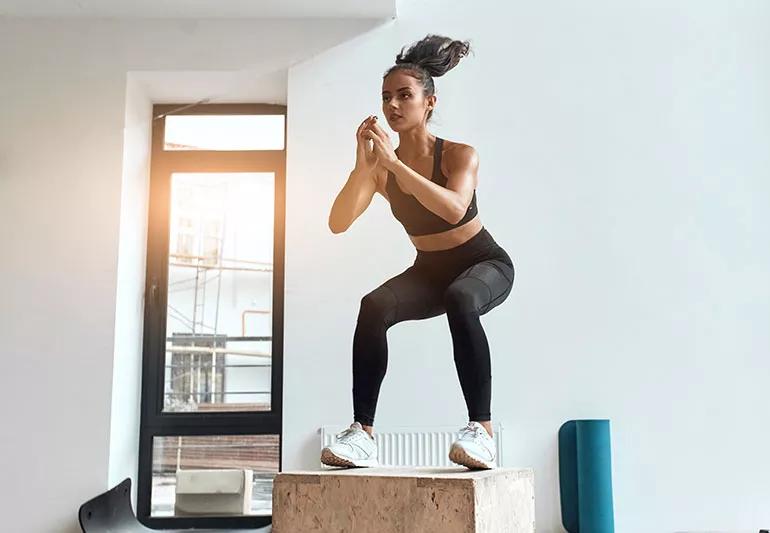Advertisement
Proper form is important when pivoting, turning and landing

As a fan, it’s upsetting to watch your favorite athlete suffer an injury. And if you’re the athlete, the immediate unmistakable “pop” you hear when you’ve torn your anterior cruciate ligament (ACL), is accompanied with dread and hopelessness. The injury can put a quick end to your season and sometimes requires surgery and extensive rehabilitation.
Advertisement
Cleveland Clinic is a non-profit academic medical center. Advertising on our site helps support our mission. We do not endorse non-Cleveland Clinic products or services. Policy
Every athlete wants an answer to the million-dollar question: “How can I avoid tearing my ACL?”
“Proper form can help athletes avoid this serious injury,” says orthopaedic surgeon, Lutul Farrow, MD.
For example, if you play soccer, basketball, tennis or volleyball, you should be especially mindful of two things:
“These cutting and planting maneuvers cause about 70% of all ACL injuries,” says Dr. Farrow. The jumping, landing and pivoting involved in these sports all place major stress on the knee’s ACL — particularly in female athletes.
Initiating a cut or landing after a jump can compromise the ACL’s ability to resist rotational forces. Planting incorrectly can overwhelm the ACL’s ability to move the knee the way it is designed to do.
The knee’s four main ligaments tether your shin bone (tibia) to your thigh bone (femur) where they meet at your knee.
Think of the ACL as the “vital stabilizer” that runs diagonally across the middle of your knee. It keeps your tibia from sliding forward from under your femur. It also limits over-rotation of your knee joint. You need the ACL to keep your knee in place when straightening and bending your legs.
Advertisement
“Men and women athletes maneuver differently in a jump or cut, which puts women at higher risk for injury,” Dr. Farrow notes.
Women tend to activate their quadriceps first, while men tend to activate their hamstrings first. This difference in activation may alter the amount of strain applied to the ACL and other knee ligaments.
In addition, after a jump, women tend to land with their knees closer together than men. Athletes who land with their knees farther apart seem to have less risk of ACL injury.
Fatigue is a hazard for all athletes. Tired athletes are more likely to use poor mechanics because their minds and bodies aren’t at 100% energy. This includes not getting enough sleep, not properly conditioning and rehabbing back into shape after an injury and poor hydration and nutrition.
If you’re suffering from fatigue, you may land with your knees closer together. This is especially true when a fatigued athlete makes a split-second decision to execute an unexpected move. Don’t take the chance. Properly rest your body before overdoing it on the court or field.
“Training programs supervised by sports medicine professionals can improve athletes’ leg strength and jump-landing techniques,” says Dr. Farrow.
Proper training decreases ACL injury rates in basketball, volleyball and soccer. The techniques that improve ACL safety can also enhance performance, and increase vertical jump height, acceleration and the ability to change direction.
Nothing can prevent ACL injuries altogether. But knowing the potential causes and maximizing your prevention strategies can stop the “pop” and its frustrating consequences.
Remember to get enough rest, treat injuries with care, hydrate and eat right, and train under proper supervision.
Advertisement
Learn more about our editorial process.
Advertisement

Concussion protocol describes the steps needed to test for concussion and return to play — timelines vary

Relieve a tight, achy and aggravated IT band, as well as hip and knee pain, with these at-home exercises

Both are forms of tendinopathy, but one is more of an acute injury caused by inflammation, while the other is the result of degeneration over time

You may have to keep your leg straight, but you can sleep in any position

Watch the weather, keep lines of communication open and make sure everyone on board has access to a personal lifejacket or flotation device

Build breaks into training routines to prevent the wear and tear behind repetitive stress

The mental block is a brain-body disconnect that causes gymnasts to lose their sense of space on flips

A more open conversation on athletes and their mental health needs is overdue

Focus on your body’s metabolic set point by eating healthy foods, making exercise a part of your routine and reducing stress

PFAS chemicals may make life easier — but they aren’t always so easy on the human body

While there’s little risk in trying this hair care treatment, there isn’t much science to back up the claims